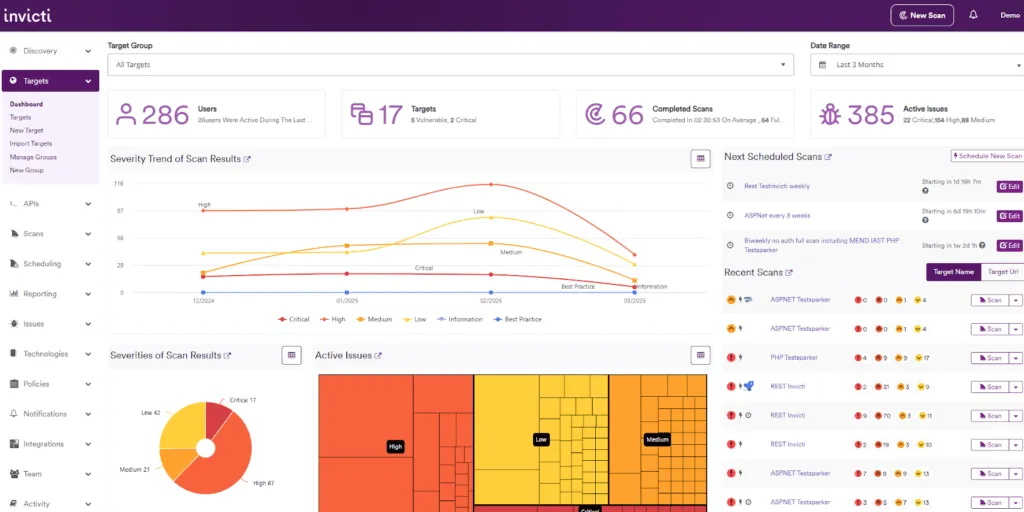The best vulnerability scanner tools
Selecting the right vulnerability scanner is critical to protecting modern digital environments that span web applications, APIs, networks, and cloud systems. This guide and top 10 list explains what to look for in today’s leading scanners.

Choosing the right vulnerability scanner is a core cybersecurity decision. Modern attack surfaces span web applications, APIs, network devices, operating systems, and cloud environments. The best vulnerability scanning tools don’t just detect vulnerabilities – they validate exploitability, reduce security risks, and help with mitigation so you can close security weaknesses before cyberattacks hit production.
What to look for in a vulnerability scanner
Vulnerability scanners vary by function and use cases. Some focus on web apps, some on APIs, and others on networks and hosts. Coverage, accuracy, automation, and actionable results matter most. In practice, applications and the APIs that back them are in the first line of fire, so applications are where most vulnerability scanning begins and where most tool consolidation happens.
Web vulnerability scanner features
Web vulnerability scanners are built to test applications running in production or staging environments. They use dynamic analysis to simulate real-world attacks, detecting issues like SQL injection, cross-site scripting, and authentication flaws. Stand-out features to look for include:
- Evidence-based scan engine: Look for scanners that don’t just flag potential issues but prove exploitability. For example, Invicti’s proof-based scanning automatically confirms many types of vulnerabilities and virtually eliminates false positives for confirmed issues. This enables teams to trust results and focus remediation where it counts.
- Discovery: A strong scanner should automatically discover web applications, subdomains, and APIs across environments to eliminate shadow IT and blind spots. Discovery ensures coverage of all running assets and is especially important for organizations with complex or distributed infrastructures.
- Flexibility in pricing and swapping out scan targets: Business needs change, and so do digital assets. The most practical scanners allow easy replacement of scan targets and flexible subscription models that scale as your application portfolio grows.
- Integration with CI/CD: Modern AppSec depends on automation. Integrations with CI/CD tools such as Jenkins, GitHub Actions, GitLab, and Azure DevOps allow developers to catch vulnerabilities early and fix them before deployment without slowing release cycles.
API security features
APIs represent a rapidly growing attack surface, which makes API vulnerability scanning essential to modern AppSec. The right tool must identify and test at least REST, SOAP, and GraphQL endpoints to detect vulnerabilities in data exposure, authentication, and business logic. Effective scanners automatically handle authentication tokens, parse complex schemas, and perform fuzzing to discover subtle flaws such as authorization bypasses or insecure parameter handling.
Comprehensive API scanners also include intelligent API discovery capabilities. They automatically find new or undocumented APIs by analyzing traffic patterns and comparing them to known assets, reducing the risk of shadow endpoints. In-depth analysis includes validation of input/output structures and response handling to confirm vulnerabilities. Scanners that integrate with CI/CD pipelines and API management platforms streamline the feedback process for developers, reducing manual effort and accelerating remediation.
Network vulnerability scanner features
Network scanners focus on identifying vulnerabilities, misconfigurations, and open ports in connected systems such as routers, switches, servers, and endpoints. They assess network devices, operating systems, and firewalls to detect outdated software, weak protocols, and missing patches.
Good network scanners integrate with patch management tools to prioritize remediation and verify fixes. They also use vulnerability templates and CVE databases to correlate findings against known security risks. For comprehensive coverage, many teams use network scanners alongside web and API testing tools to detect vulnerabilities across the entire infrastructure stack, ensuring consistent mitigation and defense against evolving cyber threats.
10 best web vulnerability scanners
1. Invicti
Invicti is the most advanced enterprise-grade vulnerability scanning and management platform available today. Built around a DAST-first approach, it focuses on identifying and validating real, exploitable risks in running applications.
Its proprietary proof-based scanning engine safely confirms many types of vulnerabilities with a proof of exploit, virtually eliminating false positives for confirmed issues. ML-powered Predictive Risk Scoring additionally helps prioritize the most critical issues already during discovery based on potential impact and exploitability.
The Invicti platform unifies DAST, SAST, SCA, API security, container security, and more, while integrating seamlessly with dozens of tools, including Jira, ServiceNow, Jenkins, and GitHub. Organizations gain a single view of all applications and risks through proof-based application security posture management (ASPM), further strengthened by Invicti’s 2025 acquisition of Kondukto.

Invicti supports all major frameworks, single-page applications, and modern API types. It combines speed, coverage, and accuracy across development and production environments to continuously reduce risk without disrupting workflows.
2. Acunetix by Invicti
Acunetix by Invicti is one of the most widely recognized web vulnerability scanners, known for its speed, reliability, and ease of use. Since its first release in 2005, it has served as an ideal solution for small to mid-sized organizations starting their AppSec journey.
While Acunetix is no longer sold as a standalone product, the best parts of its scan engine, checks, and automation capabilities live on within the Invicti DAST component of the Invicti Platform. Current Acunetix users will find a familiar interface and improved performance in Invicti’s modernized, unified AppSec environment.
This evolution means the trusted Acunetix technology now operates as part of a broader platform that delivers the accuracy, scalability, and integration capabilities required for today’s enterprise security programs.
3. Burp Suite Enterprise (PortSwigger)
Burp Suite Enterprise adds automation on top of Burp’s Professional edition, backed by Portswigger’s pen testing heritage. It can run scheduled scans and surface security vulnerabilities for dev and security teams. It’s aimed at security professionals who still need their manual tools in an enterprise context, but achieving enterprise-grade automation, API discovery, and CI/CD depth may require tuning and extensions.
4. Rapid7 InsightVM
InsightVM focuses on infrastructure and host-level vulnerability management with live risk scoring. It inventories network devices and operating systems, correlates CVEs, and integrates with ticketing to drive mitigation and patch management. For web app DAST specifically, Rapid7 offers InsightAppSec, but InsightVM remains the AppSec backbone in many programs.
5. Nessus (Tenable)
Nessus by Tenable is a staple vulnerability scanner (originally an open-source product) with a large plugin library that detects vulnerabilities across servers, databases, network services, and applications. It identifies misconfigurations, open ports, and missing patches, and offers templates for common assessments. Many teams pair Nessus with a dedicated DAST to better cover application-layer security flaws.
6. Qualys VMDR
Qualys VMDR is a cloud-delivered platform for asset discovery, vulnerability detection, and remediation orchestration at scale. It connects findings to CVEs and threat intel, supports distributed scanning in cloud environments, and provides a variety of dashboards. Qualys also offers web testing modules, but VMDR is best known for broad VM across hybrid estates.
7. ZAP by Checkmarx (formerly OWASP ZAP)
ZAP by Checkmarx is the current name for the widely used open-source OWASP ZAP project, now sponsored by Checkmarx. ZAP functions as an intercepting proxy and automated scanner to detect web security flaws, supports headless use in pipelines, and offers an add-on marketplace for extensions and scripts. It’s the go-to free DAST tool for individual users and also provides the basis for several commercial tools, but it’s known to be noisy and time-consuming to set up in automated workflows. Complex auth, modern single-page flows, and API formats require additional configuration and add-ons.
8. Intruder.io
Intruder wraps OpenVAS and ZAP engines in a managed SaaS solution with continuous attack surface monitoring. It discovers changes, scans new assets, and produces compliance-friendly reports using templates. It is designed for SMBs that want low-overhead vulnerability scanning tools across internet-facing assets.
9. Detectify
Detectify specializes in external attack surface scanning. It discovers subdomains and monitors changes, then runs automated web checks to detect vulnerabilities and misconfigurations. It is fast to start and useful for continuous monitoring of public-facing assets, with limited depth on authenticated areas and APIs.
10. OpenVAS (Greenbone)
OpenVAS is an open-source network scanner used to map services, detect CVEs, and assess configuration risks across hosts and network devices. It was forked from the original Nessus engine and is now maintained by Greenbone Networks as part of their GVM suite. It is flexible and free, but setup and tuning can be complex. Many teams complement OpenVAS with DAST for full application coverage.
The Invicti way: Reducing risk early with a DAST-first security strategy
Traditional AppSec programs often rely purely on static testing tools that overwhelm teams with non-actionable alerts and theoretical risks. A DAST-first approach, as championed by Invicti, flips this model by scanning live applications to uncover vulnerabilities that attackers could actually exploit.
By validating exploitability in real time, Invicti provides actionable intelligence rather than noise. Teams can focus on fixing verified issues first, reducing both workload and risk exposure.
With integrated discovery, automated testing, predictive risk analytics, and proof-based ASPM, Invicti enables organizations to maintain continuous visibility and control across their entire application landscape – from development to production.
This is more than scanning. It is an intelligent, risk-driven security strategy designed to secure what truly matters. Request a demo to see the Invicti Platform in action in your environment.
Frequently asked questions
FAQs about vulnerability scanning tools
A tool that analyzes running apps and APIs to detect vulnerabilities such as XSS, SQL injection, authentication errors, and insecure configurations on the web server.
Invicti is the best all-round solution for comprehensive application and API security, covering both discovery and DAST-validated testing. Nessus and Qualys VMDR are strong choices for infrastructure and host VM, while OpenVAS is an open-source option for network scanning.
Invicti DAST is the best automated scanner for testing web apps and APIs. It’s offered as part of the Invicti Platform and provides proof-based validation, automation, and integration into CI/CD pipelines.
The main three types are application, network, and endpoint scanners, but many more types exist. Notably, web apps are now largely backed by APIs, so an enterprise-grade application scanner should also incorporate API security scanning.
Accuracy, automation, CI/CD integration, and the ability to verify real risks. The right tool should fit seamlessly into your development and security workflows while providing actionable, validated results.


